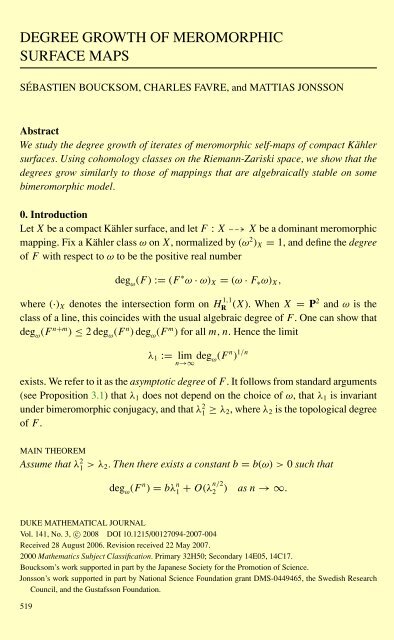A NULLSTELLENSATZ FOR AMOEBAS
A NULLSTELLENSATZ FOR AMOEBAS
A NULLSTELLENSATZ FOR AMOEBAS
Create successful ePaper yourself
Turn your PDF publications into a flip-book with our unique Google optimized e-Paper software.
DEGREE GROWTH OF MEROMORPHIC<br />
SURFACE MAPS<br />
SÉBASTIEN BOUCKSOM, CHARLES FAVRE, and MATTIAS JONSSON<br />
Abstract<br />
We study the degree growth of iterates of meromorphic self-maps of compact Kähler<br />
surfaces. Using cohomology classes on the Riemann-Zariski space, we show that the<br />
degrees grow similarly to those of mappings that are algebraically stable on some<br />
bimeromorphic model.<br />
0. Introduction<br />
Let X be a compact Kähler surface, and let F : X X be a dominant meromorphic<br />
mapping. Fix a Kähler class ω on X, normalized by (ω 2 ) X = 1, and define the degree<br />
of F with respect to ω to be the positive real number<br />
deg ω (F ):= (F ∗ ω · ω) X = (ω · F ∗ ω) X ,<br />
where (·) X denotes the intersection form on H 1,1<br />
R<br />
(X). WhenX = P2 and ω is the<br />
class of a line, this coincides with the usual algebraic degree of F . One can show that<br />
deg ω (F n+m ) ≤ 2deg ω (F n )deg ω (F m ) for all m, n. Hence the limit<br />
λ 1 := lim<br />
n→∞<br />
deg ω (F n ) 1/n<br />
exists. We refer to it as the asymptotic degree of F . It follows from standard arguments<br />
(see Proposition 3.1) thatλ 1 does not depend on the choice of ω, thatλ 1 is invariant<br />
under bimeromorphic conjugacy, and that λ 2 1 ≥ λ 2, where λ 2 is the topological degree<br />
of F .<br />
MAIN THEOREM<br />
Assume that λ 2 1 >λ 2. Then there exists a constant b = b(ω) > 0 such that<br />
deg ω (F n ) = bλ n 1 + O(λn/2 2 ) as n →∞.<br />
DUKE MATHEMATICAL JOURNAL<br />
Vol. 141, No. 3, c○ 2008 DOI 10.1215/00127094-2007-004<br />
Received 28 August 2006. Revision received 22 May 2007.<br />
2000 Mathematics Subject Classification. Primary 32H50; Secondary 14E05, 14C17.<br />
Boucksom’s work supported in part by the Japanese Society for the Promotion of Science.<br />
Jonsson’s work supported in part by National Science Foundation grant DMS-0449465, the Swedish Research<br />
Council, and the Gustafsson Foundation.<br />
519
















